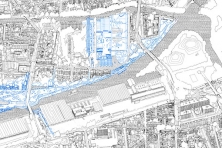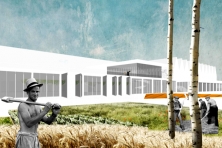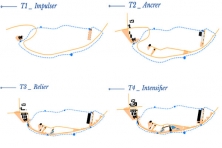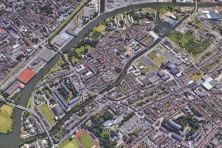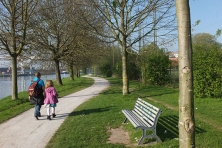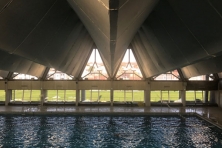Écoto(w)ne
Lille (FR) - Winner
TEAM DATA
Team Representative: Édouard Cailliau (FR) – architect
Associate: Thomas Lecourt (FR) – architect
Contributors: Delphin Colin (FR) – landscaper; Romain Leignel (FR) – illustrator
Studio Rijsel
35 rue Stappaert, 59000 Lille (FR)
+33 645 915 469 – contact@studiorijsel – studiorijsel.com
See the complete listing of portraits here
See the site page here

E. Cailliau, T. Lecourt, D. Colin & R. Leignel
INTERVIEW
Click on the images to enlarge
1. How did you form the team for the competition?
Thomas et Edouard - Studio Rijsel – have worked together in an architecture studio in Lille for 7 years, until they started their own structure Studio Rijsel and it is quite natural that they chose to answer Europan on the Lille site, city where they live, work and which is subject to many studies. After the reflections begun, they asked Delphin to exchange and embrace all the landscape dimension of the site. In collaboration, Romain helped designing and building models and a large part of the project's main isometry.
2. How do you define the main issue of your project, and how did you answer on this session main topic: the place of productive activities within the city?
It is a multi-scalar reflection. The answer was iteratively built between uses and rhythms. How does the city (an organism) live throughout the day (from morning to evening), as the week goes on (working days and weekends) and as the year progresses (the sequence of seasons)? Thus, project situations appeared on the project sites and beyond, with the aim of focusing on the existing city and the landscape in place, in short: to the « déjà-là » (already present). By a fine dosage and attention to context, the productive city appeared on different scales, from the metropolitan to the ultra local, to avoid the pitfall of a zoning response not adapted to the island of Bois Blancs.
3. How did this issue and the questions raised by the site mutation meet?
Two vast changing sites: a deserted industrial wasteland and an Olympic swimming pool soon to be moved. Two emblematic buildings: the height of a silo, a remnant of a gravitational production, the pleated roof of the pool, vocabulary of major sports equipment. Two territories with marks on and in contact with water.
Our intention was to work on these two sites by the same key of entry: the relation with water and the richness of this eco-system (at the same time with landscape and urban terms!)
Two movements come together to cross, on one side the smooth and slow revitalization of the city, on the other the re-naturalization of the banks of the Deule. This re-naturalization is also included in the island by "sanctuary" zones allowing urban breaths and participating in the understanding of the territory in which one finds oneself.
These two energies participate in a slow, gentle and non-intrusive process.
4. Have you treated this issue previously? What were the reference projects that inspired yours?
We have also worked on this smooth and slow transition process of the city on various territorial projects, without having the productive dimension. Thanks to our origins, this issue of industrial cards is at the centre of our practice since our territory is filled with wastelands caused by industrial decline and whose new uses revitalize the city and reinvent it permanently. This sedimentation, these palimpsests are markers of time, signs of the past but also testify to the possibility of the city to write itself. A form of resilience, a body in constant mutation.
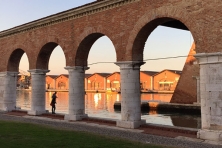
5. Urban-architectural projects like the ones in Europan can only be implemented together with the actors through a negotiated process and in time. How did you consider this issue in your project?
The question of time is central in a territorial project. To this, we added the notion of respect. Respect of the territory, the inhabitants, the heritage in order to really transform the project into a stratified process, the successive phases creating a coherent "whole". Four steps led the project:
1 - Impulse At first the operation must reveal the scale of the island of Bois blancs. Simple devices enable to impel future development (ferryboats to reconsider the island's periphery as an entity, associative management of « les jardins d’abondance », first tree plantations on the banks, etc ...)
2 - Anchor The project must secondly be anchored in the fabric and uses of its environment. Beyond temporary practices it is necessary to register in the long run and to develop uses of proximities (housing, small equipment, public spaces of district)
3 - Connect Building on the foundation established in steps 1 & 2, the project must find its pace of development. The sites are known and once practiced, they can stretch to their limits.
4 - Intensify Each part (Boschetti, Dormoy, Berges) receives a program that allows it to ensure its dissemination; In contrast to the locomotive logic that attracts investments, we see an interest in the development tool that allows an operation to radiate fully. For example it is the Museum of Standart that comes after the realization of the productive patios to promote their know-how.
6. Is it the first time you have been awarded a prize at Europan? How could this help you in your professional career?
Edouard had already been awarded at Europan 12 on the Regionale 2016 site in Germany. But this is the first time that we are winners together, locally, and via our Studio, in the first year of its creation. This is for us a form of intellectual recognition, a local anchor that is dear to us. This is the occasion of to be listened by those who make the city today, and, we hope, a beginning of an adventure for a rich territory...
